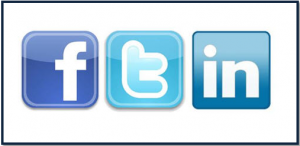I often receive calls from business owners who immediately ask me, “Can you set up my Facebook fan page for me?” I tell them that I can take care of that for them, but I then follow up by asking, “Why Facebook?”
Here are a few of the typical responses I get:
Oh, well we want to do social media. Isn’t that what we need to have?
Everyone’s on Facebook.
Once I get Facebook, I can get rid of my website!
While Facebook is perhaps the most well-known social media site, it’s not for every business. And it certainly isn’t a means for getting rid of your company website.
The truth is that there are a number of social media sites available for companies to leverage and grow their business. And each of them has unique characteristics that can help businesses in different ways. The key is selecting the right ones, and then effectively executing the strategy for these platforms.
The most popular social media sites for business are LinkedIn, Facebook and Twitter. I also recommend YouTube or blogging for some of my clients. And, there are dozens of specialty sites outside of these including: Pinterest, Google+ and even MySpace.
Most businesses probably have some form of social media and they need to learn how to make better use of it. Or they might have social media channels and they’re not sure why they chose the ones they did or if these channels are appropriate for reaching their target audience.
Here are a few guidelines for helping to determine the proper social media channels for reaching your target audience – narrowing it down by just “The Big 3” – Facebook, LinkedIn, and Twitter.
- Offers the ability to reach a diverse audience made up of primarily consumers
- Largest age segment is 21-24-year-olds, followed by 18-20-year-olds
- Even usage among men and women
- Great for sharing, especially videos and photos as well as blog posts and Q&A’s
Other factors to consider: Facebook business pages are becoming more refined and easier to integrate into an overall marketing strategy. Facebook has the ability to integrate with thousands of third-party apps. While the population of Facebook users continue to grow (approximately 1 billion users), the overall engagement has slightly decreased among my clients due to over-saturation of the medium and Facebook’s Edgerank scoring.
- Primarily a channel for reaching a business audience
- Largest age segment is 35-44-year-olds, followed by 45-54-year-olds
- Even usage among men and women
- Useful for building business connections; attractive for B2B companies
Other factors to consider: LinkedIn is sometimes referred to as a “resume site.” While the channel can be used for recruitment, it’s important not to overlook the power of LinkedIn as a business networking tool. LinkedIn has two gems: the advanced search tool, which allows you to target your audience by title, company, keyword, and location and groups which are great for connecting with like-minded professionals and creating a community/forum for discussion related to your business.
- Allows for short updates (140-character limit) in real-time
- Largest age segment is 30-49-year-olds, followed by 18-29-year-olds (both of these segments represent nearly 85% of users)
- Slightly higher usage among women (54%) than men (46%)
- Useful for potentially reaching a national, and even international audience, by using hashtags and/or engaging with influencers (industry experts)
- Often used as a customer service outlet. In fact, one million people view tweets about customer service each week. Because Twitter is wide-open, brands can be mentioned by a customer and can engage with the customer this way.
Other factors to consider: There is a love/hate relationship with Twitter primarily because many do not understand it. However, it’s fairly easy to master once you understand Twitter’s language and how to filter content. There is something known as a hashtag (the pound sign or “#”) which is used to categorize content and allow you to join a community based on common interests. This is a powerful tool for being found and for finding others. Twitter is also powerful due to the potential of a re-tweet (RT), in which someone shares your content on their Twitter stream, allowing you to reach an entirely new audience.
Need help deciding which channel is best for your business? Want in-depth information on each channel? Be sure to check out the “Social Media Jump Start Kit!”
Sources:
The Chrome Source
Undercover Recruiter
Good breakdown of the different social platforms! I think Google!+ will be definitely one to get going on (if not already) as this will be be advantageous in search results and in particular Google+Local will become even more essential for online marketing. (I can hear my clients groaning - oh no, not another one)...
Hi Midge! Thank you! Stay tuned. I'll talk about this a little more in the next blog!